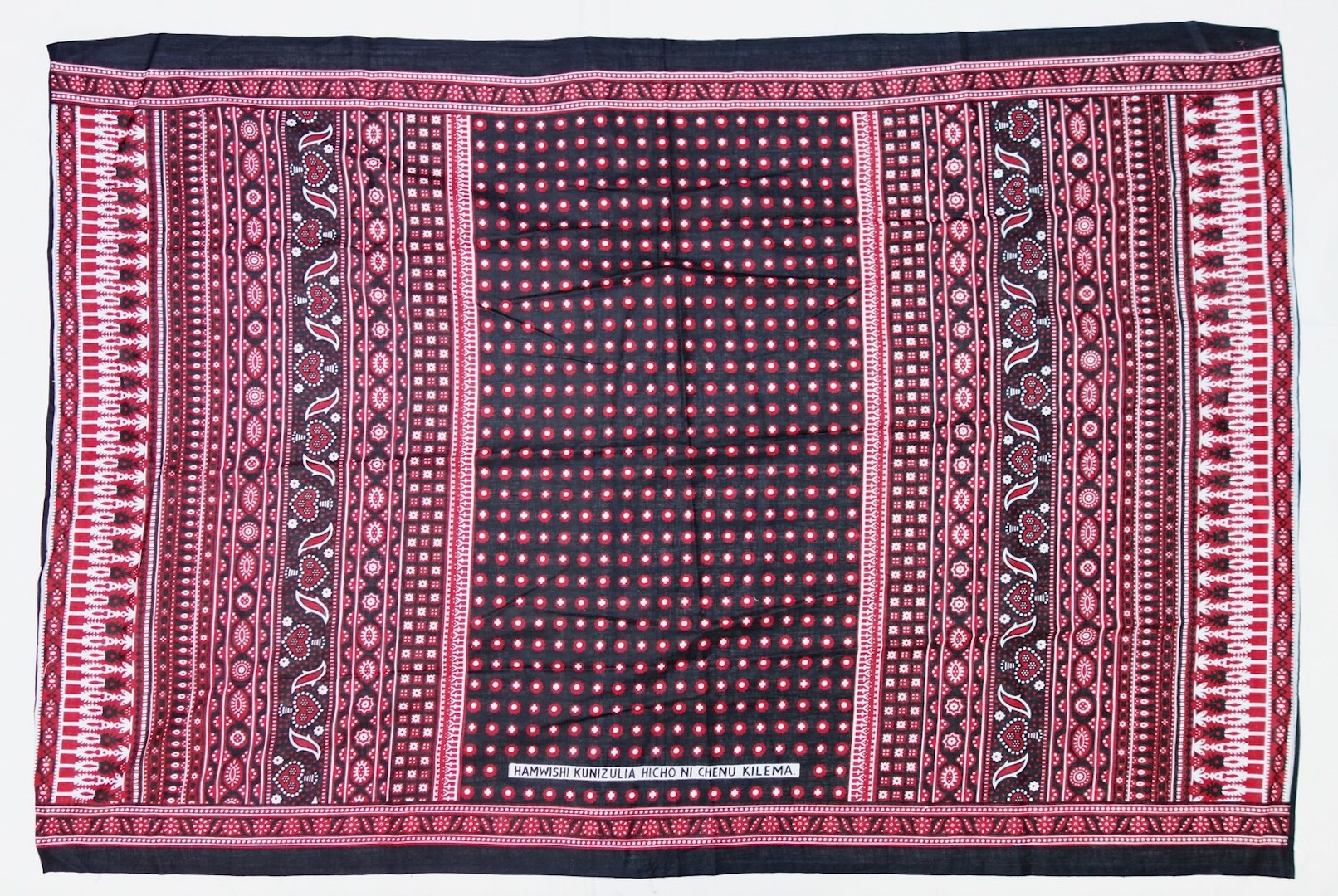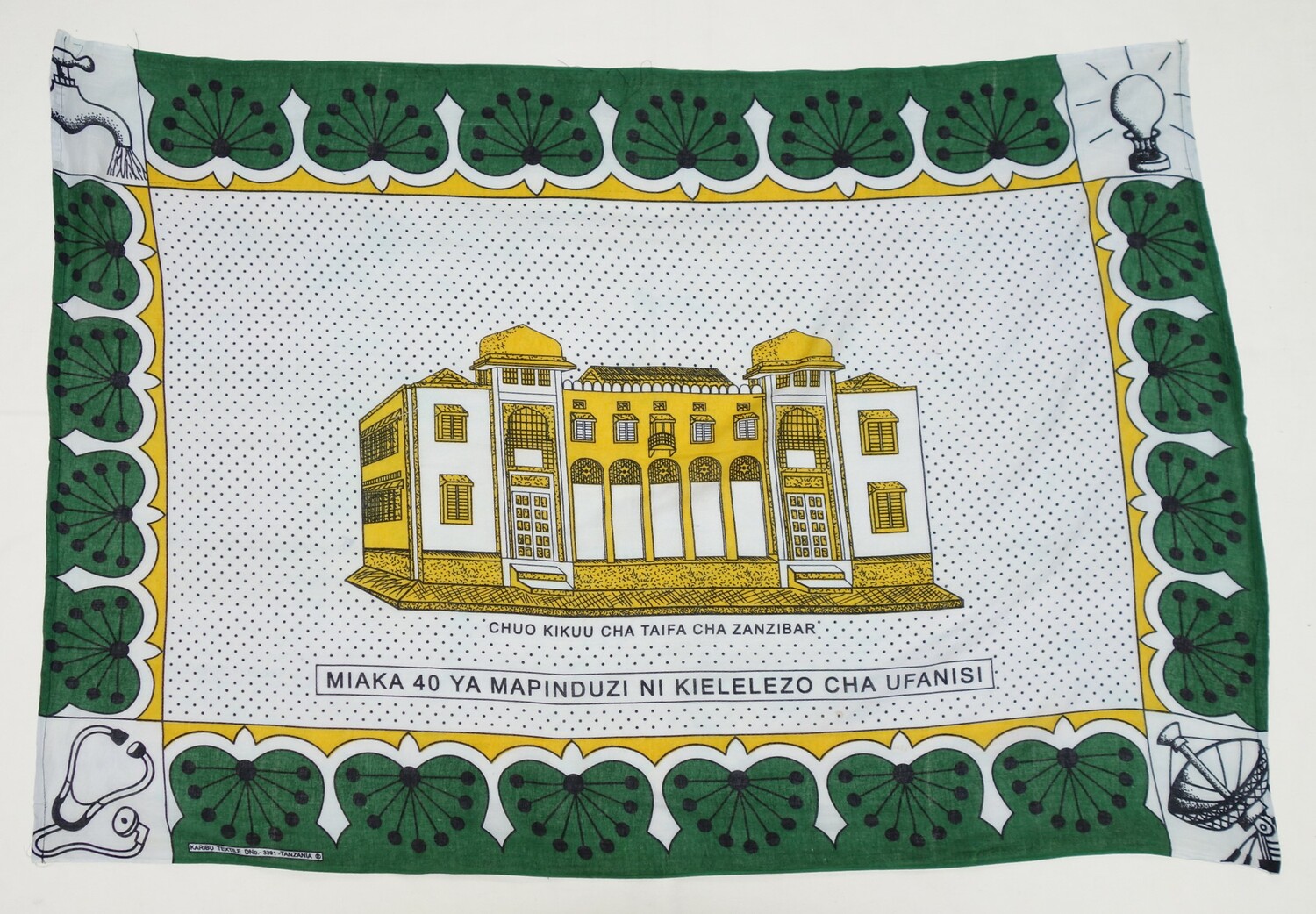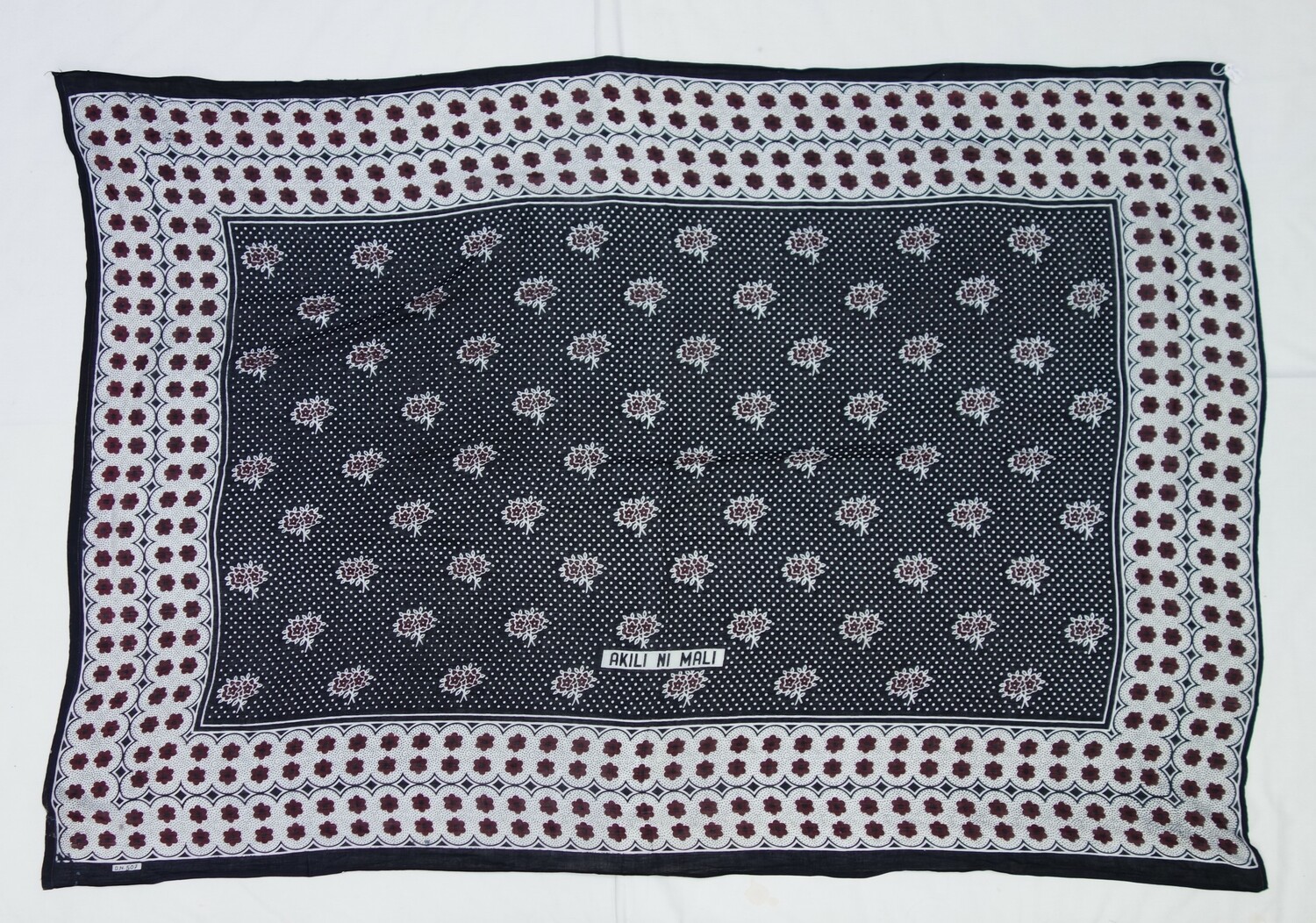by Marije Boerma (20-04-2024), who recently completed a Research Master of colonial and global history at Leiden University. The topic of her thesis was the East African kanga.
Black and speckled with red and white designs of hearts, crosses and dots: the kisutu cloth, for wrapping around the body, from the island of Zanzibar along the East African coast may be the oldest type of kanga. The TRC has a large collection of these garments, and hence it seemed appropriate to write a short blog on the subject.

A kanga is generally 1.5 x 1 m in size and sold in pairs. It has a central field, often with a main image or logo in the middle and framed by a border (TRC 2004.0148). There is normally a text on the lower side, but there are exceptions such as a kanga without text, which is called a kanga bubu or 'mute kanga.' Sometimes a kanga has no central motif, just a patterned ground, with or without a text (TRC 2004.0144).

All kangas have 'names,' that simply refer to the central logo, text or pattern. Naming a kanga because of a feature is a standard practice in Zanzibar. In the past, the names may have evolved from kanga salespersons shouting and describing the features of the newest kanga on the market. For example, a kanga with a mango may be called an embe kanga, or 'mango kanga.'

The kisutu is a particular Zanzibari form, which although perhaps at first was not referred to as a kanga was gradually adopted as a kanga and sold as such in the kanga market. A kisutu is about the same size as a kanga, but it is sold individually (TRC 2004.0162). They usually have a patterned main field, flanked by broad borders. They may or may not have a text on the lower side.
Early recordings of kisutu's appearance on the textile market date back to the 1850s, when they were introduced as part of a fashion craze. Over 100 years ago, before Zanzibar was known for its beaches and tourism, it was a gateway to mainland East Africa. Zanzibar was long accustomed to a continuous flow of merchants who brought exciting new textiles from Asia, the Middle East and Europe (compare the TRC online exhibition Textile Travels).
 Swahili women hair-dressing, Retrieved from https://tinyurl.com/4v3bztks.Mirrors, clocks, and ceramics are all examples of foreign goods that gave a sense of status to some privileged Zanzibaris. The island was a cosmopolitan space where fashion trends changed quickly. As one British traveller remarked in 1905, “Zanzibar sets the fashion for all that part of the world, as Paris does of Europe,” influencing the fashion trends for mainland East Africa.
Swahili women hair-dressing, Retrieved from https://tinyurl.com/4v3bztks.Mirrors, clocks, and ceramics are all examples of foreign goods that gave a sense of status to some privileged Zanzibaris. The island was a cosmopolitan space where fashion trends changed quickly. As one British traveller remarked in 1905, “Zanzibar sets the fashion for all that part of the world, as Paris does of Europe,” influencing the fashion trends for mainland East Africa.
The origin story of the kisutu is a testament to the importance of fashion trends in mid-19th century Zanzibari society. It has been said that when the kisutu first came to the market it was a must-have for any fashionable Zanzibari woman.
One woman who was eager to partake in the trend asked her husband to buy it for her. When he refused, she became so enraged that she stabbed him to death. When questioned by the authorities about how she committed the murder she replied, “Kisu tu!” which means 'Just a knife'. That day, at the marketplace and along the seaside boulevard the town criers shouted the shocking news of the day, “Kisu tu!” The story of a fashion-crazed woman and her blind rage spread quickly and the kisutu became known as the kanga that was worth killing for.
The origin story of the kisutu is largely based on folklore and is still recounted today in Zanzibar. But early existence of the kisutu is documented in photographs and British trade reports. The photograph of ‘Swahili women hairdressing’ was taken in a studio between 1897 to 1899. The seated woman combing her companion’s hair wears a kisutu. Almost 50 years after its introduction on the fashion scene it was worn as a household item.
And as we know at the TRC, textiles can change their meaning for people over time. Today the kisutu is considered to be traditional wear and is worn by brides at their weddings. What was once a fashion trend became a traditional Zanzibari staple. The black, red, and white colours of the kisutu also have developed some symbolic meanings. The red colour would symbolize the bride’s virginity, the black the pain she may experience in the act of the loss of her virginity and the white would represent sperm.

Additionally, there are kisutu that are made in green and blue and are reserved for women who remarry. A woman marrying a second time wears a green kisutu, and one remarrying a third time wears a blue one. The TRC is fortunate to have a green kisutu in its collection (TRC 2009.0332).
Another addition to the kisutu is the text printed at the bottom. A kanga is 'officially' a kanga if it has a text or jina at the bottom of the cloth. The kisutu now in the TRC collection (TRC 2004.0162) reads “Hamwishi kunizulia hicho ni chenu kilema,” or 'You keep asking me questions, and this is your problem.' In short, “Don’t be so nosy.”
Unknown to the many tourists who may flip through the piles of textiles at the market of the historical Stone Town of Zanzibar, the kisutu's local significance has lasted for over a century, from a fashion trend to traditional bridal wear.
Sources
- Mackenzie Moon Ryan, A Manufacturing and Design History of Kanga Textiles.
- Mahfounda Alley Hamid, Kanga: it is more than meets the eye – a medium of communication.
- Robert Nunez Lyne, A Short History of the Southern East in the Nineteenth Century.










